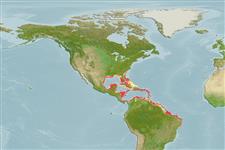Environment: milieu / climate zone / depth range / distribution range
Écologie
marin récifal; profondeur 3 - 50 m (Ref. 9626). Subtropical; 34°N - 12°S, 99°W - 32°W
Western Atlantic: Bermuda, southeastern Florida (USA), and the Bahamas to Brazil.
Length at first maturity / Taille / Poids / Âge
Maturity: Lm 19.0 range ? - ? cm
Max length : 33.0 cm TL mâle / non sexé; (Ref. 7251); common length : 25.0 cm TL mâle / non sexé; (Ref. 3798); poids max. publié: 550.00 g (Ref. 5217)
Épines dorsales (Total): 12; Rayons mous dorsaux (Total): 15-17; Rayons mous anaux: 8. Broad black area above line from dorsal fin origin to tip of lower caudal fin lobe, including upper part of caudal peduncle and both lobes of tail. Striking colored species, with a silvery body, black back and tail (Ref. 26938). With narrow yellow stripes, the broadest mid-lateral (Ref. 13442).
Inhabits clear inshore and offshore reefs (Ref. 9710) and adjacent grass beds, often in schools (Ref. 3798). Feeds on crustaceans (Ref. 3798). Marketed fresh (Ref. 3798).
Life cycle and mating behavior
Maturité | Reproduction | Frai | Œufs | Fécondité | Larves
Oviparous, distinct pairing during breeding (Ref. 205).
Robins, C.R. and G.C. Ray, 1986. A field guide to Atlantic coast fishes of North America. Houghton Mifflin Company, Boston, U.S.A. 354 p. (Ref. 7251)
Statut dans la liste rouge de l'IUCN (Ref. 130435)
Menace pour l'homme
Reports of ciguatera poisoning (Ref. 30303)
Utilisations par l'homme
Pêcheries: intérêt commercial mineur; Aquarium: Aquariums publics
Plus d'informations
RéférencesAquacultureProfil d'aquacultureSouchesGénétiqueElectrophoresesHéritabilitéPathologiesTraitementNutrientsMass conversion
Outils
Articles particuliers
Télécharger en XML
Sources Internet
Estimates based on models
Preferred temperature (Ref.
123201): 23.7 - 28, mean 26.8 °C (based on 288 cells).
Phylogenetic diversity index (Ref.
82804): PD
50 = 0.5000 [Uniqueness, from 0.5 = low to 2.0 = high].
Bayesian length-weight: a=0.01778 (0.01068 - 0.02961), b=2.99 (2.85 - 3.13), in cm total length, based on LWR estimates for this species & Genus-body shape (Ref.
93245).
Niveau trophique (Ref.
69278): 2.2 ±0.1 se; based on diet studies.
Generation time: 3.4 ( na - na) years. Estimated as median ln(3)/K based on 1
growth studies.
Résilience (Ref.
120179): Milieu, temps minimum de doublement de population : 1,4 à 4,4 années (K=0.3).
Fishing Vulnerability (Ref.
59153): Low to moderate vulnerability (33 of 100).
Nutrients (Ref.
124155): Calcium = 27.5 [13.0, 65.9] mg/100g; Iron = 0.614 [0.299, 1.244] mg/100g; Protein = 19 [17, 21] %; Omega3 = 0.139 [0.061, 0.282] g/100g; Selenium = 16.7 [7.3, 36.7] μg/100g; VitaminA = 28.4 [6.3, 119.2] μg/100g; Zinc = 0.918 [0.551, 1.493] mg/100g (wet weight);
